

Top 10 SEO Copywriting Tips (Plus Top Tools)
source link: https://www.semrush.com/blog/seo-copywriting/
Go to the source link to view the article. You can view the picture content, updated content and better typesetting reading experience. If the link is broken, please click the button below to view the snapshot at that time.

What is SEO copywriting? SEO copywriting is the process of creating well-optimized content that attracts users and allows search engines to represent your content on SERPs better.
And in this guide, we’ll go over the basics of SEO copywriting and tips and tricks to ensure that your writing is top-notch.
What is SEO Copywriting?
SEO copywriting is content that is well written for both users and search engines. Three simple reasons why you need SEO copywriting for your business:
- To attract more qualified traffic at minimal cost
- To create trust by providing the content your audience is searching for
- To convince readers to take action (download your app, subscribe to your podcast, make a purchase, etc.) and/or convert them into customers
10 Steps to SEO Copywriting Success
Well, let’s get right into it. You want the keys to SEO copywriting success; we’ll give them to you.
A well-thought-out piece of content starts from the beginning. We’ll outline X steps to ensure that you create optimized content that is easily understood by search engines and users alike.
Find the Right Keywords to Target
with Keyword Magic Tool

1. Find the Right Keywords
An SEO copywriter needs to identify the keywords for the content piece that they’re writing. Some of these factors will be important when planning out the strategy for a piece of content:
- Text type (blog post, landing page, eBlast)
- The purpose of the text (informative, subscribe, transaction, etc.)
- Audience
- Style and/or tone of voice
- Right keywords to target
Let's talk about, arguably, one of the most critical factors on this list: keywords. Keywords are terms that people search for on the internet to find information.
Successfully targeting the right keywords while keeping search intent in mind will help you get there.
You shouldn't guess at the right keywords — make use of online software to assist with your keyword research.
Semrush’s Keyword Magic Tool can help. Type in your primary search term (“seed” keyword), and the tool will show you semantically related keywords. Play with filters and group the keywords by search volume, keyword difficulty, or other metrics.
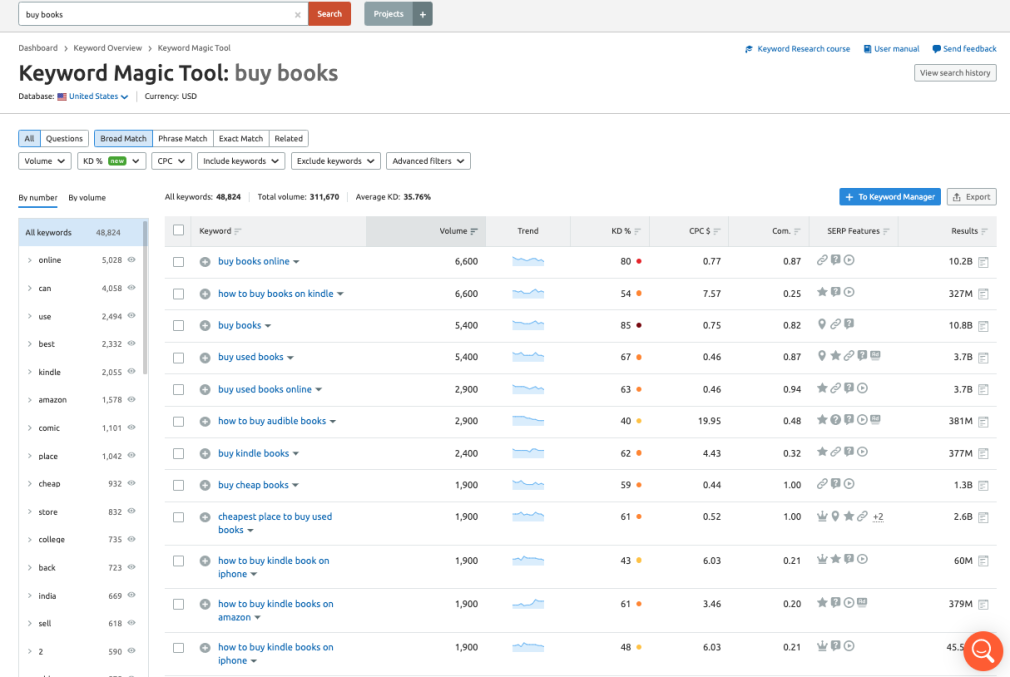
There are a variety of factors that go into choosing which keywords are the right keywords to target. Some businesses or writers may need to focus on high-volume, competitive keywords. However, most writers and businesses should look for mid-to-high volume keywords with low difficulty for targeting, i.e., relatively easy to target, yet have solid search volumes.
PRO TIP: We recently updated Keyword Difficulty scores to be even more accurate than ever before. Read up on our keyword difficulty update for more information!
2. Find Questions That People Ask
Search engines are now, essentially, answer engines. Resources like People Also Ask on Google, AlsoAsked.com, and forums like Quora or Reddit can be great starting points for uncovering what questions arise around your topic.
You can also use Semrush’s Topic Research Tool, which provides headlines, related questions, and more based on the keywords you enter.
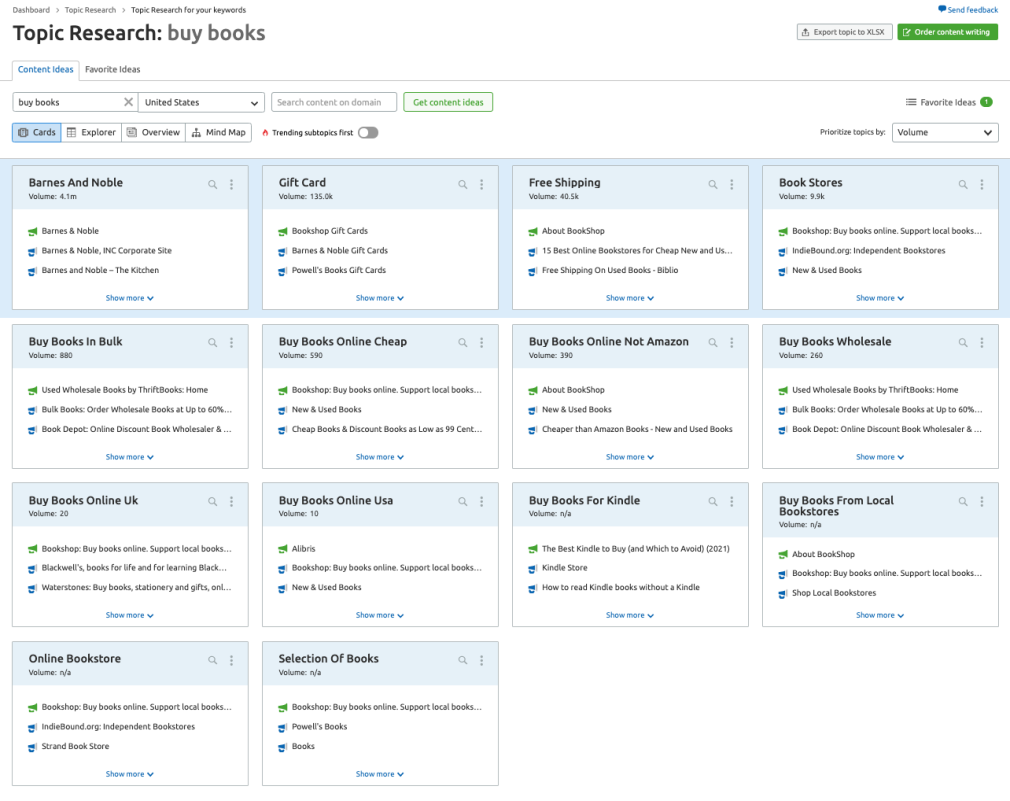
Once you have identified which questions pop up most frequently, you can develop a superior answer to what other SERP competitors are writing. See what they’re doing, make improvements, and be sure to answer the question thoroughly.
Do you need to add every question? No! Just the ones that are relevant to your business.
For example, if you own a car dealership that only sells cars and doesn’t service them, you likely wouldn’t create dedicated content to answering servicing questions since it’s a service your business doesn’t provide.
3. Identify and Map Search Intent
Each webpage and the content that is placed on it should be focused on user intent. Your content will vary depending on different stages of the customer journey. With that in mind, your keywords should also vary based on the different intents.
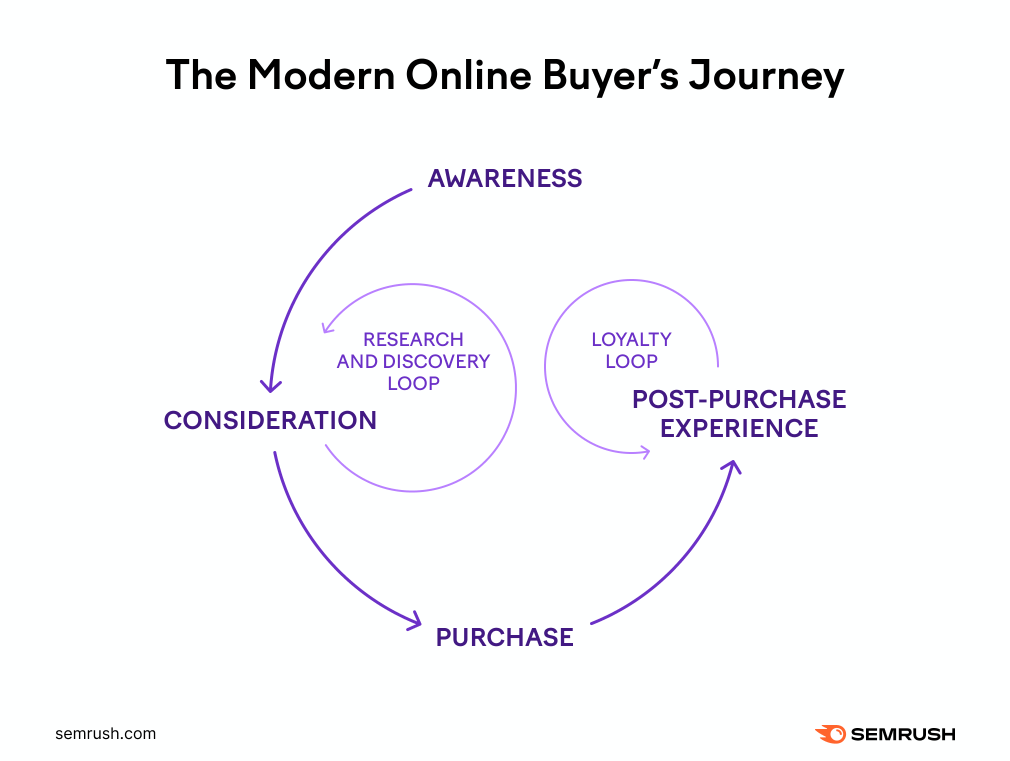
By identifying the reason behind a user typing in your target keyword in search engines, you will uncover the “keyword intent.”
There are four types of intent searches:
- Informational intent: Users want to find more information on a specific topic, product, or industry. Example: “best coffee machines”
- Navigational intent: Users intend to visit a specific site or page. Example: “Nespresso coffee machine types”
- Commercial intent: Users consider a purchase and want to investigate their options. Example: “coffee machines comparison”
- Transactional intent: Users aim to purchase a product/service. Example: “buy a new Nespresso coffee machine”
Your copy should target keywords that closely match the search intent of the user.
4. Check Competitors' Articles for Your Target Keywords
Enter your primary keyword in Google’s search bar (or using Semrush’s Keyword Overview Tool or SEO Content Template) and look at the top 10 search results to determine what these pages have in common. This is what a good writer should do in the first place to collect optimization and copywriting ideas from your main competitors.
Semrush makes it easy to quickly get SEO recommendations for your future content using the SEO Content Template. You will see how your top-10 competitors use your target keywords in the article, which semantically related words they are likely to include, the sites that link to them, their readability score, and their text length.
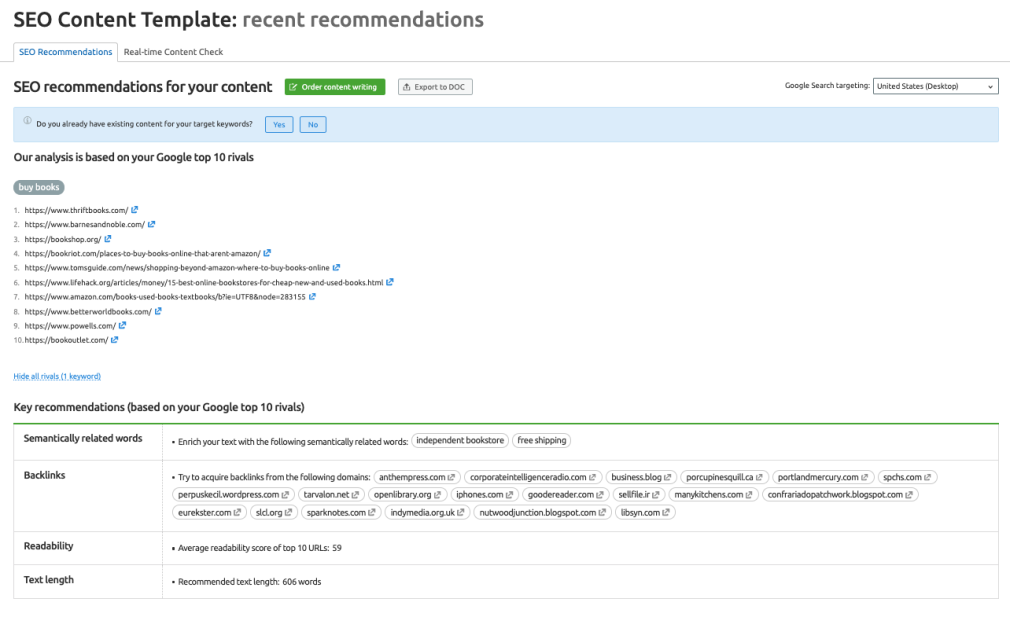
You can export all this data to help you prepare your content outline to ensure you hit target keywords and monitor what domains may be relevant to start planning your backlink outreach.
5. Gather Original Data
An efficient tactic to engage readers is to share unique and original data. This can help you generate backlinks to your page, which will positively affect your rankings.
An external writer definitely won't have all the insights into your company (although they can ask the right questions before starting work). An internal writer may not have enough information, either. So, gathering data is essential. But what if you don’t have enough data to share?
- You can set up surveys and ask customers about their preferences, lifestyle, etc. And then share the results of your poll. Chances are, bloggers and news sites writing on your industry can refer to your survey results or just share them across social media.
- Look through your sales data to uncover patterns. This is especially interesting to look at during times of crisis when many industries are under severe stress (negative or positive). Industry writers will appreciate some inside data to look at.
- You can also use customer-generated content. Ask your customers to share success stories with some stats on how your product or service has helped them increase their sales. Examples: “Save up to 80% more time on keyword research.”
Accurate data, original visuals, and catchy sentences encourage readers to share your message with their followers on Twitter, Facebook, LinkedIn, etc. Brainstorm and come up with data sources your company has on hand, and start collecting data for content.
6. Optimize Your Header, Meta Title, & Meta Description
The first thing readers see when looking at Google’s search engine results pages is the page’s title (it may correspond to the headline of your copy, but not necessarily).
You want the title to be enticing and offer the reader information that they need — this can boost your organic click-through rate (CTR) and increase pageviews.
The title should help both people and search engines determine what your content is about and what information they will find on your page.
How you describe your content to users and search engines is significant. Here are the recommendations for meta titles, meta descriptions, and your H1.
Meta Title:
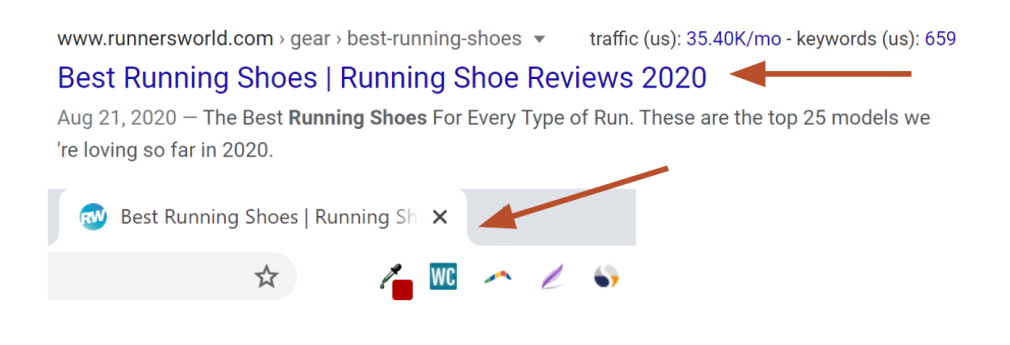
Recommendations for your meta titles:
- It is unique and includes your target keyword.
- It is 55-60 characters long. Google truncates title tags that are longer than 55-60 characters, and they have a 600-pixel width limit (but this can sometimes vary depending on the device being used).
- Sends a message that accurately matches the content and search intent. If the content doesn’t live up to users’ expectations after clicking the title, they will just bounce off the page. This will indicate to Google that you are not providing relevant content to your users, which might, in turn, affects your rankings.
- Includes a Call-to-Action. A CTA is a crucial addition to your title or meta-description. CTAs should motivate users to go to the website.
Meta Description:

Recommendations for your meta descriptions:
- Contains target keywords
- Calls-to-action and/or targets an emotion
- It consists of 140-160 characters (1-2 sentences). If it is too long, it won’t fit, Google will truncate it, and people will not understand what your site can provide
- It should be unique and describe a webpage. Make it meaningful — offer a compelling reason to visit the specific page. Google encourages including certain information like price, manufacturer, etc., scattered throughout a page
H1 Tag:
Recommendations for your H1 tags:
- It fits within the 600-pixel width. Within this width, readers can see the full title. Otherwise, Google truncates it
- May include numbers, for example, “10 Quick Ways to Create the Perfect Title”. Articles with list headlines get up to 2x more traffic and up to 2x more shares than other types
- May include bracketed clarifications like [interview], [video], [2021]. Articles with bracketed clarifications perform 38% better than those without clarifications, suggesting that readers like to have a full picture of what they will get when they click
- Includes actionable words like “learn,” “take,” “boost,” “enhance,” etc. This may help readers understand what they will gain from the page
- Motivates users to go to the website — emotional triggers may help get users’ attention and create interest
7. Create Organized, Easy-to-Read Content
Google's Gary Illyes at Pubcon Austin 2020 said that flow and readability are essential for search engine rankings. So, make sure your text is readable. If the text’s vocabulary is over their head or the reading level is too advanced, you will lose your visitor.
Half of the US population reads below an 8th-grade reading level. It is not because they are incapable of reading more complex copy; they just choose not to (especially online). This means that your copy will not get shared, liked, or lead to conversions if it is too difficult for some audiences.
You have to know your audience. Professionals will not be okay with a 7-8th grade reading level if they are researching services. You need to earn their trust by sounding professional, so for a more educated and experienced audience, up to a 12th-grade reading level is fine.
Here are the keys to what makes readable copy:
- Good structure
Good structure guides both users and search engines through your content as smoothly as possible. Each new point should be reflected in H2, H3, and H4 headings. According to our research, 36% of articles with H2 and H3 tags have better performance in traffic, shares, and backlinks.
- Skimmable headlines that inform without reading
Readers often skim before they read. According to the study by Nielsen Norman Group, only 16% of people will read your copy word by word.
Make sure your headlines inform a reader of what they will gain by reading individual paragraphs or the page as a whole.
When you think about search intent and what answers people need, you can give those answers in your headlines and elaborate in the following paragraphs.
- Clear and informative paragraphs
Just like headlines, readers like to skim through paragraphs to find the information they need quickly. Vast walls of text are daunting and challenging to scan.
Nielsen Norman Group's Eye-Tracking Study revealed that users read in an F-shaped pattern:
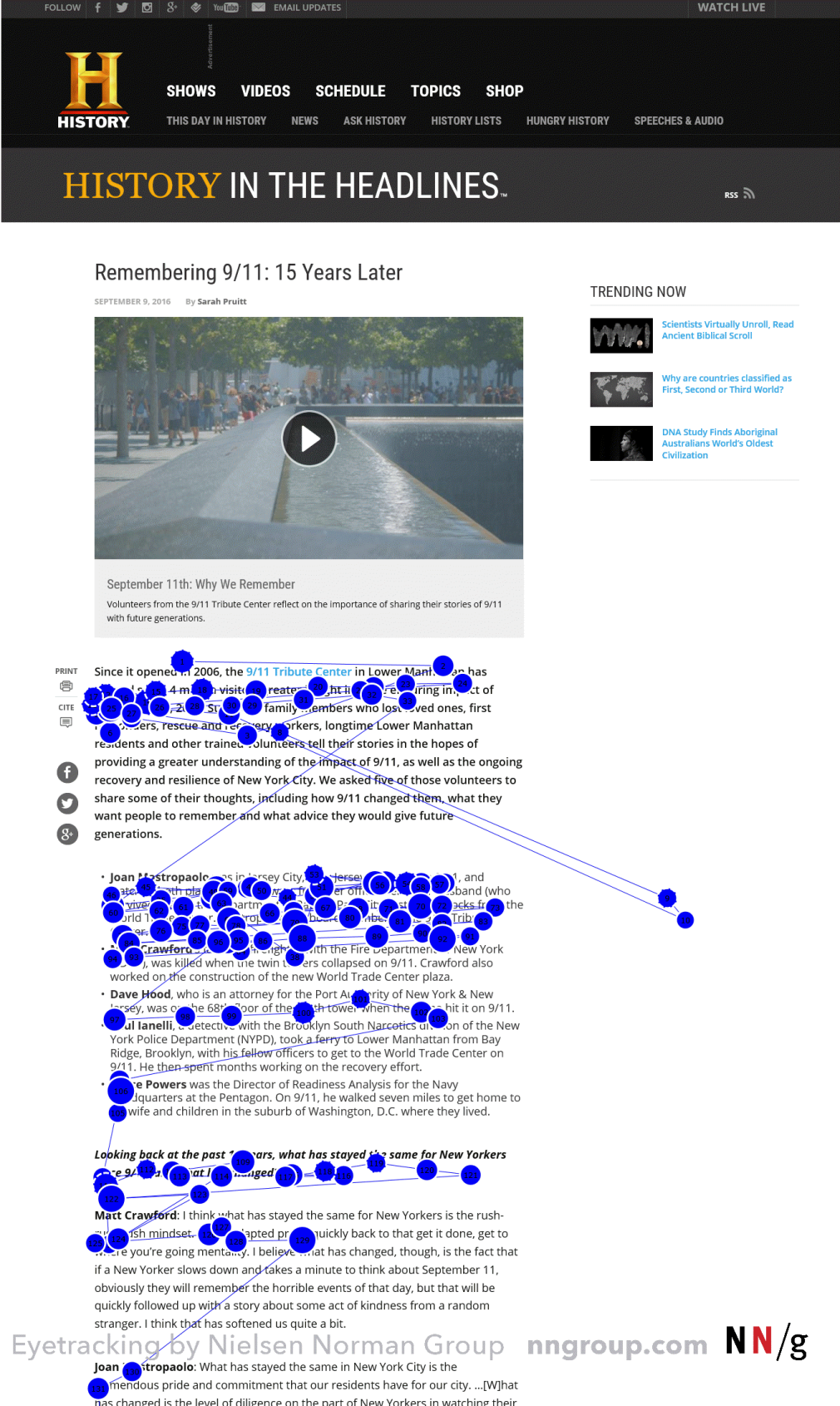 Image credit: Nielsen Norman Group's Eye-Tracking Study
Image credit: Nielsen Norman Group's Eye-Tracking Study Make sure the copy’s paragraphs are short and start with the key message. Clarity and concision are the keys to excellent readability and user experience — the more the white space, the better the user experience.
- Bullet points and numbered lists
Long paragraphs can be broken up with bullets or numbered lists and graphics that inform the user.
These techniques help you guide your reader through the copy without making them work too hard to find the information they need — they are also skimmable, which is a bonus.
- Short sentences
With shorter sentences, you are once again making the reader’s job easier and your message more digestible.
- Subtopics are covered within the copy
Keep in mind a few points from your previous research: target keywords, structure of the top-ranking pages, users’ queries, and questions.
They can be separated into paragraphs or bundled together but should be included in the article and placed in a logical order.
- Simple vocabulary
Make sure to limit the use of words that are too difficult to read. At the same time, you can educate your readers on your industry or brand terms, but you must explain what they mean and make the explanation as easy as possible.
If you want to check the readability score, Semrush’s SEO Writing Assistant extension can help. It automatically analyzes your target keywords and suggests the optimal readability level for your copy based on your top rivals.
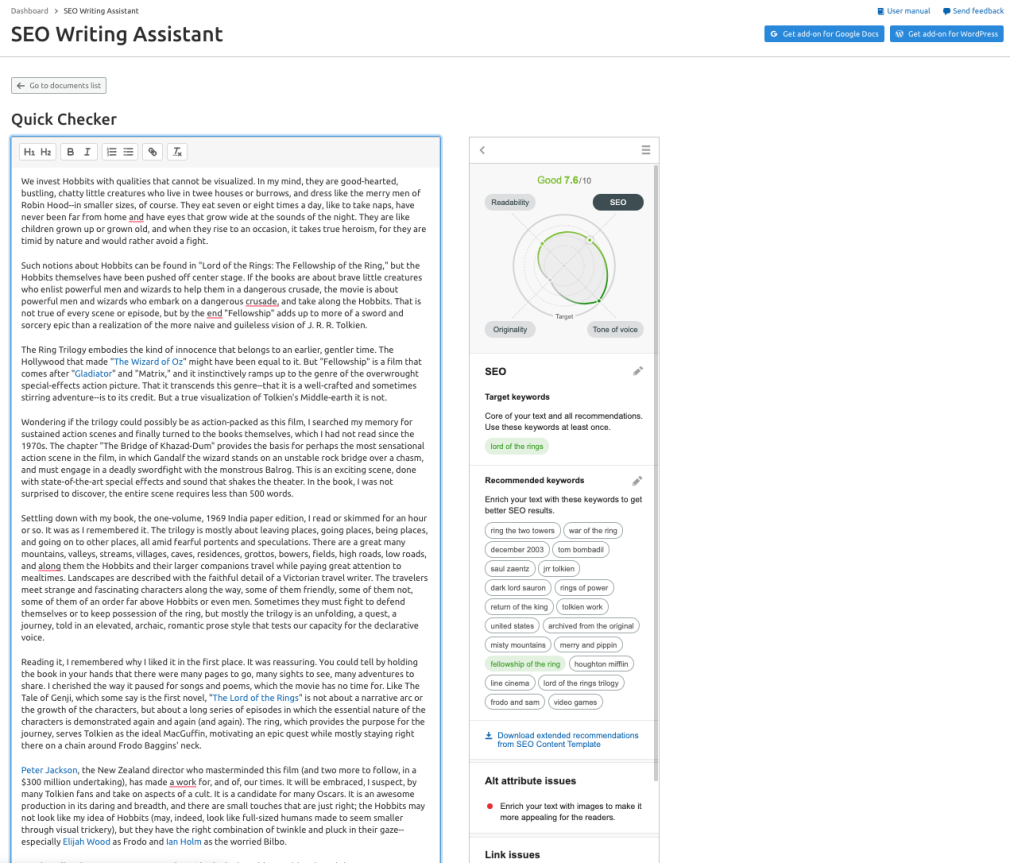 Text courtesy of Roger Ebert's film review of The Lord of the Rings: The Fellowship of the Ring.
Text courtesy of Roger Ebert's film review of The Lord of the Rings: The Fellowship of the Ring.With this tool, you will also:
- Find out which sentences are too long.
- Discover which parts of the copy may not be original.
- Ensure your text is perfectly structured for a target keyword and written in an SEO-friendly style.
- Make sure your content piece complies with your overall brand voice — casual, neutral, or formal.
8. Include Visuals
A picture is worth a thousand words. Use visuals throughout your page — videos, images, charts, infographics, etc. In 2019, 74% of marketers used visuals in more than 70% of their content — because it works.
Videos and informative images, charts, and infographics can increase readers’ time on page and trigger them to share the visual across social media accounts. This strategy could potentially increase the reach of your content, and the media, when appropriately optimized, could be used in Google SERPs.
And don’t forget about adding image alt tags (descriptions for images you use throughout your copy). With Google’s image search on the rise, you should tap into this trend by adding short yet clear descriptions for your visuals. You’ll find more information in our Image SEO and Alt Tags Guide.
9. Include CTAs (Calls-to-Action)
SEO copywriting has a clear purpose — to drive users further along the customer journey. That is where calls-to-action come in handy.
Remember us mentioning “search intent?” If users land on copy that was produced for informational intent, include a CTA that will direct them to another page that targets keywords with navigational intent, and so forth.
From a copywriting perspective, this will improve your copy’s conversion rate and the ROI of your content. From an SEO perspective, this may improve your page views, decrease bounce rate, and send positive engagement signals to Google.
Pro tip: Include a few CTAs throughout your copy as readers might not read the entire page. Add one CTA after a few opening paragraphs, another one somewhere in the middle of your page, and one more at the very end.
10. Good Internal & External Linking Structure
When you include a link from your copy to an internal or external page, you’re simply following Google's philosophy that “there’s always more information out there.”
But why would you drive people off your page with internal and external links?
- By linking to external content, you can build trust around your copy. Any time you include some stats or want to support a claim you are making, linking to an authoritative source can support your point.
- By linking to internal content, you can guide users through their customer journey and point them towards pages that convert. You can also link to some other content that expands on the idea you are covering. This will show that you are a valuable source of quality content, resulting in the reader spending more time on your site.
Here’s more information about the importance of internal links and how to do it right. And here’s a bit on external links, too.
Pro tip: Ensure the external link opens up in a new window to avoid distractions from your copy.
Top SEO Copywriting Tools
Need help with your content creation? If you’d prefer to order SEO-optimized content, Semrush offers Content Marketplace. The Content Marketplace is a place where you can order your content written by an experienced copywriter.
However, if you’re keen on doing your SEO copywriting yourself, here are some tools we’d recommend taking a look at to help with all the above (and more!):
Top Semrush Tools for SEO Copywriting:
- Keyword Magic Tool is used to narrow down your keyword research and finding the best keywords to target with your copy.
- Topic Research is used to discover new content ideas and uncover what people search for around your topic (subtopics and questions).
- Organic Research is used to find the best-performing rivals for your topic to learn from.
- SEO Writing Assistant will help you optimize your content based on your top 10 rivals in Google rankings. Download its add-on to check your content’s SEO friendliness and originality and to adjust your copy’s readability and consistency of your tone of voice as you write.
- On-Page SEO Checker can help you set up monitoring after your copy is published to get SEO recommendations for improving your rankings.
- SEO Content Template to get SEO recommendations for your future content based on top-10 competitors.
Other Helpful Writing and Editing Tools for Writers:
- Google Search Console and Google Analytics for analyzing your pages’ performance. See what has been working so far, what you might need to work on, and what can be improved based on user behavior on your pages.
- Google Trends to find out what topics are trending and for keyword research (it shows the search query’s volume and related keywords to look at).
- Grammarly will help you find all the issues wrong in your copy’s grammar and improve the clarity and engagement of your content.
- Hemingway App will help you improve your readability as it checks your copy for over-complicated sentences.
- AlsoAsked.com will show you questions that arise around your chosen topic.
- Typeform/ Google Forms can be used to create and run surveys to gather data.
- Short URL/ Bitly can be utilized to shorten your page’s URL, track link clicks, and the performance of social media sharing.
- Canva will help you create custom images, social shares, animations, and infographics for your website, articles, and social accounts.
- Unsplash/ Flickr/ Pixabay will help you find high-quality, royalty-free images.
- Google Docs and Google Sheets for enhancing team collaboration on the copy and helping with content calendar tracking.
Now that you have the tips and tools at your disposal, it’s time to get started. Good luck creating your SEO-optimized content.
Find the Right Keywords to Target
with Keyword Magic Tool

Recommend
About Joyk
Aggregate valuable and interesting links.
Joyk means Joy of geeK